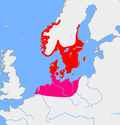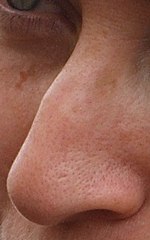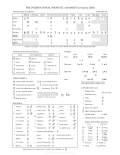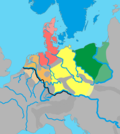A nasal vowel is a vowel that is produced with a lowering of the soft palate (or velum) so that the air flow escapes through the nose and the mouth simultaneously... 12 KB (1,346 words) - 04:31, 27 April 2024 |
quadrilateral IPA vowel diagram on the right. There are additional features of vowel quality, such as the velum position (nasality), type of vocal fold... 57 KB (7,108 words) - 12:52, 11 April 2024 |
Nasalization (redirect from Nasal accent) Many languages have nasal vowels to different degrees, but only a minority of world languages around the world have nasal vowels as contrasting phonemes... 11 KB (1,249 words) - 23:58, 29 April 2024 |
Portuguese phonology (section Nasal vowels) consonant hereafter denoted as /ɲ/ is realized as a nasal palatal approximant [j̃], which nasalizes the vowel that precedes it: ninho ([ˈnij̃u ~ ˈnʲij̃u ~ ˈɲij̃u]... 86 KB (8,755 words) - 16:37, 14 March 2024 |
nasalized flaps, nasal glides, and nasal vowels, as in French, Portuguese, and Polish. In the IPA, nasal vowels and nasalized consonants are indicated... 20 KB (2,352 words) - 16:37, 16 February 2024 |
 | Elfdalian (section Nasal vowel sounds) preserve nasal vowels from Proto-Norse; all other Nordic dialects with nasal vowels have developed them later as a result of the loss of a nasal consonant:... 38 KB (3,321 words) - 15:28, 20 April 2024 |
French phonology (redirect from French vowels) Standard French. Notable phonological features include its uvular r, nasal vowels, and three processes affecting word-final sounds: liaison, a specific... 54 KB (5,195 words) - 21:41, 20 April 2024 |
 | Proto-Germanic language (section Nasal vowels) Proto-Germanic nasal vowels were joined in Old Norse by nasal vowels from other sources, e.g. loss of *n before s. Modern Elfdalian still includes nasal vowels that... 130 KB (12,128 words) - 09:47, 26 March 2024 |
 | Guarani language (section Nasal harmony) layout feature of glyph composition. Only stressed nasal vowels are written as nasal. If an oral vowel is stressed, and it is not the final syllable, it... 47 KB (4,083 words) - 19:15, 25 April 2024 |
Yoruba language (section Vowels) Its vowel system is the most traditional of the three dialect groups, having retained nine oral-vowel contrasts and six or seven nasal vowels, and an... 55 KB (5,245 words) - 23:35, 15 April 2024 |
Polish phonology (section Nasal) preserved nasal sounds that existed in Proto-Slavic. However, recent sources present for modern Polish a vowel system without nasal vowel phonemes, including... 81 KB (7,446 words) - 01:16, 4 March 2024 |
each system. This may be a vowel such as /a/ (hiragana あ); a consonant followed by a vowel such as /ka/ (か); or /N/ (ん), a nasal sonorant which, depending... 52 KB (4,202 words) - 18:34, 13 April 2024 |
 | Human nose (redirect from Nasal ridge) nasal cavity, contains specialised olfactory cells responsible for this function. The nose is also involved in the function of speech. Nasal vowels and... 78 KB (9,094 words) - 09:13, 4 April 2024 |
 | Romance languages (section Vowel prosthesis) any nasal consonants, and nasal consonants not immediately followed by a vowel were eventually dropped. In French, nasal vowels before remaining nasal consonants... 171 KB (16,356 words) - 16:21, 30 April 2024 |
 | International Phonetic Alphabet (redirect from IPA vowels) mean phonetic voicing, nor a vowel; for example, in VoQS ⟨Ṽ⟩ is "nasal voice" (that is, nasalization), not a nasal vowel as it would be read in IPA notation... 160 KB (15,573 words) - 10:47, 29 April 2024 |
 | The mid central vowel (also known as schwa) is a type of vowel sound, used in some spoken languages. The symbol in the International Phonetic Alphabet... 29 KB (1,721 words) - 06:58, 28 April 2024 |
 | Polish language (section Vowels) The traditional set comprises 23 consonants and 9 written vowels, including two nasal vowels (ę, ą) defined by a reversed diacritic hook called an ogonek... 96 KB (8,592 words) - 13:26, 30 April 2024 |
Old Polish (section Loss of vowel length) of a word), use of the letter ⟨ꟁ⟩ to write the short nasal vowel (⟨ꟁꟁ⟩ for the long nasal vowel), use of the letter ⟨g⟩ to write /j/, reserving ⟨q⟩ for... 34 KB (3,718 words) - 20:35, 28 March 2024 |
 | nosinė, "nasal e") is a letter in the Polish, Lithuanian and Dalecarlian alphabets. It is also used in Navajo to represent the nasal vowel [ẽ] and Kensiu... 8 KB (688 words) - 20:49, 12 April 2024 |
Bru language (section Nasal vowels) a preceding a breathy vowel sound in the Western Bru dialects. It can also be heard as nasal [h̃] when preceding a nasal vowel in the Western dialects... 14 KB (946 words) - 00:11, 11 January 2024 |
Kensiu language (section Nasality) Thailand. There are 28 vowels in the Kensiu language: 14 oral monophthongs and 12 nasal monophthongs, as well as 1 oral and 1 nasal diphthong. Front, central... 30 KB (3,691 words) - 13:47, 27 April 2024 |
 | Shipibo language (section Nasal) different from the nasal vowel phonemes /ĩ, ɯ̃, õ, ã/. Oral vowels in syllables preceding syllables with nasal vowels are realized as nasal, but not when a... 9 KB (777 words) - 06:47, 3 November 2023 |
 | Edo language (section Vowels) State and Bayelsa State, Nigeria. There are seven vowels, /i e ɛ a ɔ o u/, all of which may be long or nasal, and three tones. Edo has a rather average consonant... 12 KB (1,000 words) - 03:10, 10 March 2024 |
Back vowel Basis of articulation Bernd J. Kröger Bilabial click (ʘ) Bilabial consonant Bilabial ejective (pʼ) Bilabial flap (ⱱ̟) Bilabial nasal (m) Bilabial... 13 KB (1,196 words) - 14:10, 20 February 2024 |
 | Siouan languages (section Vowels) there are no posited nasal consonants in Proto-Siouan. Nasal consonants only arise in daughter languages when followed by a nasal vowel. In addition, there... 14 KB (1,287 words) - 08:51, 3 March 2024 |
 | Sandawe language (section Vowels) related forms. Long vowels are written double, aa, and long nasal vowels with a tilde, ã. Long vowels are about 50% longer than short vowels. In morpheme-final... 21 KB (2,116 words) - 08:25, 8 February 2024 |
 | Osage language (section Vowel clusters and long vowels) vowels tend to become nasalized adjacent to another nasal vowel or consonant when there is no intervening obstruent. On the other hand, final nasal vowels... 19 KB (1,886 words) - 15:49, 6 April 2024 |
 | Seneca language (section Nasal vowels) Project. The nasal vowels, /ɛ̃/ and /ɔ̃/, are transcribed with tremas on top: ⟨ë ö⟩. Depending on the phonetic environment, the nasal vowel ⟨ë⟩ may vary... 39 KB (4,329 words) - 17:27, 29 March 2024 |
 | Portuguese orthography (section Vowels) that a vowel is stressed and the quality of the accented vowel and, more precisely, its height: á, é, and ó are low vowels (except in nasal vowels); â,... 61 KB (6,127 words) - 21:34, 17 April 2024 |

